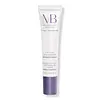What's inside
What's inside
 Key Ingredients
Key Ingredients

 Benefits
Benefits

 Concerns
Concerns

 Ingredients Side-by-side
Ingredients Side-by-side

Water
Skin ConditioningOleyl Erucate
EmollientGlycerin
HumectantDimethicone
EmollientHydrolyzed Hazelnut Protein
Skin ConditioningCetearyl Alcohol
EmollientCeteth-20 Phosphate
CleansingSteareth-10
EmulsifyingSorbitan Stearate
EmulsifyingPalmitoyl Grape Seed Extract
Skin ConditioningCucumis Melo Fruit Extract
Skin ConditioningSafflower Oil/Palm Oil Aminopropanediol Esters
Skin ConditioningAloe Barbadensis Leaf Juice
Skin ConditioningHydrogenated Phosphatidylcholine
EmulsifyingCholesterol
EmollientBisabolol
MaskingSodium Hyaluronate
HumectantAlcohol
AntimicrobialCaprylyl Glycol
EmollientEthylhexylglycerin
Skin ConditioningBiosaccharide Gum-4
Skin ConditioningHydrogenated Vegetable Oil
EmollientMagnesium Ascorbyl Phosphate
AntioxidantDicetyl Phosphate
EmulsifyingAcrylates/C10-30 Alkyl Acrylate Crosspolymer
Emulsion StabilisingMicrocrystalline Cellulose
AbsorbentCellulose Gum
Emulsion StabilisingDisodium EDTA
Sodium Hydroxide
BufferingBenzoic Acid
MaskingChlorphenesin
AntimicrobialPhenoxyethanol
PreservativeMica
Cosmetic ColorantWater, Oleyl Erucate, Glycerin, Dimethicone, Hydrolyzed Hazelnut Protein, Cetearyl Alcohol, Ceteth-20 Phosphate, Steareth-10, Sorbitan Stearate, Palmitoyl Grape Seed Extract, Cucumis Melo Fruit Extract, Safflower Oil/Palm Oil Aminopropanediol Esters, Aloe Barbadensis Leaf Juice, Hydrogenated Phosphatidylcholine, Cholesterol, Bisabolol, Sodium Hyaluronate, Alcohol, Caprylyl Glycol, Ethylhexylglycerin, Biosaccharide Gum-4, Hydrogenated Vegetable Oil, Magnesium Ascorbyl Phosphate, Dicetyl Phosphate, Acrylates/C10-30 Alkyl Acrylate Crosspolymer, Microcrystalline Cellulose, Cellulose Gum, Disodium EDTA, Sodium Hydroxide, Benzoic Acid, Chlorphenesin, Phenoxyethanol, Mica
Water
Skin ConditioningPanax Ginseng Root Extract
EmollientGlycerin
HumectantDipropylene Glycol
HumectantCaprylic/Capric Triglyceride
Masking1,2-Hexanediol
Skin ConditioningPentaerythrityl Tetraethylhexanoate
EmollientNiacinamide
SmoothingButylene Glycol Dicaprylate/Dicaprate
EmollientCetearyl Alcohol
EmollientSorbitan Olivate
EmulsifyingCetearyl Olivate
Butylene Glycol
HumectantHydrogenated Lecithin
EmulsifyingTromethamine
BufferingCarbomer
Emulsion StabilisingGlyceryl Stearate
EmollientMacadamia Ternifolia Seed Oil
EmollientAdenosine
Skin ConditioningTheobroma Cacao Extract
Skin ConditioningDextrin
AbsorbentCholesterol
EmollientPolyglyceryl-10 Oleate
Skin ConditioningRetinal
Skin ConditioningBrassica Campestris Sterols
EmollientPhytosteryl/Behenyl/Octyldodecyl Lauroyl Glutamate
Skin ConditioningSilica
AbrasiveSodium Hyaluronate
HumectantTocopherol
AntioxidantAluminum/Magnesium Hydroxide Stearate
Emulsion StabilisingPotassium Cetyl Phosphate
EmulsifyingPentaerythrityl Tetra-Di-T-Butyl Hydroxyhydrocinnamate
AntioxidantCeramide NP
Skin ConditioningPalmitoyl Tripeptide-5
Skin ConditioningDisodium EDTA
Ethylhexylglycerin
Skin ConditioningWater, Panax Ginseng Root Extract, Glycerin, Dipropylene Glycol, Caprylic/Capric Triglyceride, 1,2-Hexanediol, Pentaerythrityl Tetraethylhexanoate, Niacinamide, Butylene Glycol Dicaprylate/Dicaprate, Cetearyl Alcohol, Sorbitan Olivate, Cetearyl Olivate, Butylene Glycol, Hydrogenated Lecithin, Tromethamine, Carbomer, Glyceryl Stearate, Macadamia Ternifolia Seed Oil, Adenosine, Theobroma Cacao Extract, Dextrin, Cholesterol, Polyglyceryl-10 Oleate, Retinal, Brassica Campestris Sterols, Phytosteryl/Behenyl/Octyldodecyl Lauroyl Glutamate, Silica, Sodium Hyaluronate, Tocopherol, Aluminum/Magnesium Hydroxide Stearate, Potassium Cetyl Phosphate, Pentaerythrityl Tetra-Di-T-Butyl Hydroxyhydrocinnamate, Ceramide NP, Palmitoyl Tripeptide-5, Disodium EDTA, Ethylhexylglycerin
 Reviews
Reviews

Alternatives
Ingredients Explained
These ingredients are found in both products.
Ingredients higher up in an ingredient list are typically present in a larger amount.
Cetearyl alcohol is a mixture of two fatty alcohols: cetyl alcohol and stearyl alcohol. It is mainly used as an emulsifier. Emulsifiers help prevent the separation of oils and products. Due to its composition, it can also be used to thicken a product or help create foam.
Cetearyl alcohol is an emollient. Emollients help soothe and hydrate the skin by trapping moisture.
Studies show Cetearyl alcohol is non-toxic and non-irritating. The FDA allows products labeled "alcohol-free" to have fatty alcohols.
This ingredient is usually derived from plant oils such as palm, vegetable, or coconut oils. There is debate on whether this ingredient will cause acne.
Due to the fatty acid base, this ingredient may not be Malassezia folliculitis safe.
Learn more about Cetearyl AlcoholCholesterol is a class of organic molecules called lipids. It helps hydrate your skin and is essential to having a healthy skin barrier.
Our skin naturally contains cholesterol in the outermost layer. Besides cholesterol, it also contains ceramides and fatty acids. Cholesterol makes up about 1/4 of your skin's outer layer and barrier. Your skin barrier is responsible for keeping allergens and microbes out. Having a healthy skin barrier is also responsible for keeping your skin firm and plump.
Our bodies use cholestrol to create vitamin D, steroid hormones, and more.
Learn more about CholesterolDisodium EDTA plays a role in making products more stable by aiding other preservatives.
It is a chelating agent, meaning it neutralizes metal ions that may be found in a product.
Disodium EDTA is a salt of edetic acid and is found to be safe in cosmetic ingredients.
Learn more about Disodium EDTAEthylhexylglycerin (we can't pronounce this either) is commonly used as a preservative and skin softener. It is derived from glyceryl.
You might see Ethylhexylglycerin often paired with other preservatives such as phenoxyethanol. Ethylhexylglycerin has been found to increase the effectiveness of these other preservatives.
Glycerin is already naturally found in your skin. It helps moisturize and protect your skin.
A study from 2016 found glycerin to be more effective as a humectant than AHAs and hyaluronic acid.
As a humectant, it helps the skin stay hydrated by pulling moisture to your skin. The low molecular weight of glycerin allows it to pull moisture into the deeper layers of your skin.
Hydrated skin improves your skin barrier; Your skin barrier helps protect against irritants and bacteria.
Glycerin has also been found to have antimicrobial and antiviral properties. Due to these properties, glycerin is often used in wound and burn treatments.
In cosmetics, glycerin is usually derived from plants such as soybean or palm. However, it can also be sourced from animals, such as tallow or animal fat.
This ingredient is organic, colorless, odorless, and non-toxic.
Glycerin is the name for this ingredient in American English. British English uses Glycerol/Glycerine.
Learn more about GlycerinSodium Hyaluronate is hyaluronic acid's salt form. It is commonly derived from the sodium salt of hyaluronic acid.
Like hyaluronic acid, it is great at holding water and acts as a humectant. This makes it a great skin hydrating ingredient.
Sodium Hyaluronate is naturally occurring in our bodies and is mostly found in eye fluid and joints.
These are some other common types of Hyaluronic Acid:
Learn more about Sodium HyaluronateWater. It's the most common cosmetic ingredient of all. You'll usually see it at the top of ingredient lists, meaning that it makes up the largest part of the product.
So why is it so popular? Water most often acts as a solvent - this means that it helps dissolve other ingredients into the formulation.
You'll also recognize water as that liquid we all need to stay alive. If you see this, drink a glass of water. Stay hydrated!
Learn more about Water